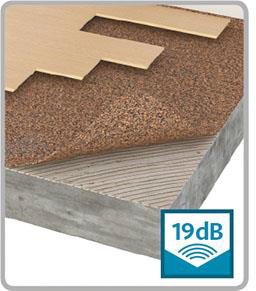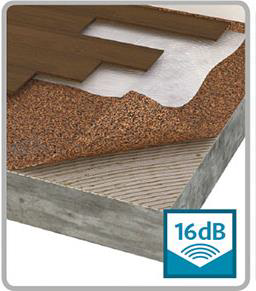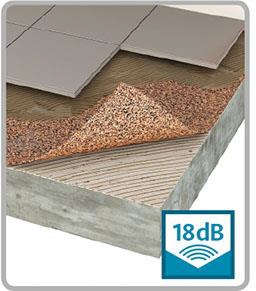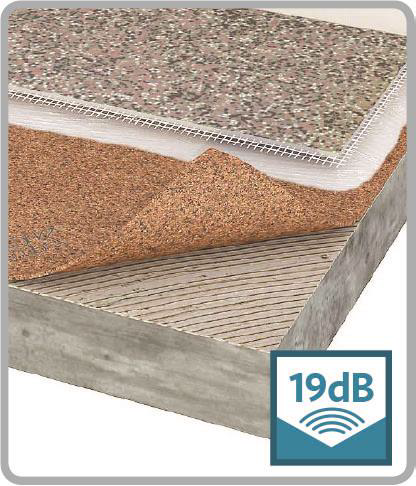Acousticork T66 Underlay

Material Description & Properties
ΔLw = 16dB–19dB
Recycled underlay for all types of flooring
- Good Insulation of Footfall and Impact Noise
- Excellent Thermal Resistance
- Suitable for All Types of Final Floors Including Heated Floor Systems
- 100% Recycled and Sustainable Product
Product Description
Agglomerated cork and recycled rubber, underlay for impact noise reduction and thermal insulation. Suitable for floating, hardwood, vinyl, linoleum and ceramic floors.
Thermal Properties (ISO 8301)
- Thermal Conductivity: 0,08 W/mK
- Thermal Resistance: 0,027 m² K/W
Acoustical Results
| Flooring | Thickness (mm) | ΔLw (dB)(1) | IIC (dB)(2) |
| Non-Glued Laminate 3 19 47 | 3 | 19 | 47 |
| Glued-Down Wood 3 16 50 | 3 | 16 | 50 |
| Ceramic (or Natural Stone) | 3 | 16 | 51 |
| 4.5 | 18 | 52 | |
| LVT | 3 | 19 | 51 |
(1) ISO 10140-3 & ISO 717-2
(2) ASTM E492-09 & ASTM E989-06
Standard Dimensions
| Thickness (mm) | Width (m) x Length (m) |
| 3 | 1 x 15 |
| 4.5 | 1 x 15 |
Packaging
1m x 15m x 3mm
Others sizes available upon request
Physical and Mechanical Properties
| Specific Weight(1) | Tensile Strength(1) | Compression at 0,7MPa(1) | Recovery after 0,7MPa(1) | Durability |
| 650-700Kg/m3 | >800KPa* | <15% | >75% | Lifetime of building |
Installation Instructions
The following installation instructions are recommended by Amorim Cork Composites but are not intended as a definitive project specification. They are presented in an attempt to be used with recommended installation procedures of the flooring manufacturers.
Room Conditions: Temperature > 10ºC / Room moisture content < 75%.
Subfloor: All subfloor work should be structurally sound, clear and level. The moisture content of the subfloor should not be more that 2.5% (CM) by weight measured on concrete subfloors.
Important Notes: Never mechanically fasten the Acoustic Cork Underlay to the flooring floor as this will severely diminish its acoustical value.
Floating Floors
Isolation vapour barrier
A p.e. insulation vapour barrier covering the entire flooring area, minimum 50mm wide vertically around the perimeter of the entire floor MUST be installed prior to the Acoustic Cork Underlay. Install by overlapping (minimum 100mm) the p.e. foil, and use an adequate tape to adhere/fix it, if necessary. After completion, p.e. foil should cover the entire concrete area without gaps. Never mechanically fasten the p.e. foil barrier with screws, nails or staples as this will severely diminish the performance of the insulation barrier.
Installations Instructions
Unpack the Acoustic Cork Underlay at least 24h before the installation and store it in the room where the installation will take place. Cut the Acoustic Cork Underlay to desired length and install directly over the entire floor pulled 30mm up the walls with crown of the rolled materials up (label side down), removing all trapped air. After completion, the Acoustic Cork Underlay should cover the entire flooring area without gaps and with joints butted tight and preferably taped.
Final Flooring
Always follow manufacturers recommended installation instructions.

Glue Down Wood
Perimeter Insulation Barrier
Install a perimeter insulation barrier minimum 35mm wide vertically around the entire perimeter of the room. This is highly recommended in order to avoid lateral propagation of impact noise. Spot adhere the strips to the wall using acrylic glue or a bead of silicone sealant (do not forget the edges of pipes, ducts, etc). Before the installation of the skirting boards, the insulation strips must be levelled (trimmed) to the height of the wood.
Installations Instructions
Unpack the Acoustic Cork Underlay at least 24h before the installation and store it in the room where the installation will take place. Use a properly sized V-notched trowel and acrylic glue to glue the Acoustic Cork Underlay to the concrete slab. Always follow the glue manufacturers recommended instructions. Cut the Acoustic Cork Underlay to the desired length and install directly over the subfloor with crown of the rolled materials up, removing all trapped air. Butt the Acoustic Cork Underlay directly against the insulation perimeter barrier already installed. Put the loose laid material back. Using a properly sized V-notched trowel, apply acrylic glue to the concrete slab. Gently, return the pulled back material to its measure place and roll in both directions with a roller. Proceed to cover the entire floor making sure that the joints are butted tight. After completion, the Acoustic Cork Underlay should cover the entire flooring area without gaps and with joints securely taped.
Final Flooring
Use polyurethane based adhesive. Always follow manufacturers recommended installation instructions.

Ceramic
Perimeter Insulation Barrier
Install a perimeter insulation barrier minimum 35mm wide vertically around the entire perimeter of the room. This is highly recommended in order to avoid lateral propagation of impact noise. Spot adhere the strips to the wall using acrylic glue or a bead of silicone sealant (do not forget the edges of pipes, ducts, etc). Before the installation of the skirting boards, the insulation strips must be levelled (trimmed) to the height of the tiles.
Installations Instructions
Unpack the Acoustic Cork Underlay at least 24h before the installation and store it in the room where the installation will take place. Use a properly sized V-notched trowel and acrylic glue to glue the Acoustic Cork Underlay to the concrete slab. Always follow the glue manufacturers recommended instructions. Cut the Acoustic Cork Underlay to the desired length and install directly over the subfloor with crown of the rolled materials up, removing all trapped air. Butt the Acoustic Cork Underlay directly against the insulation perimeter barrier already installed. Put the loose laid material back. Using a properly sized
V-notched trowel, apply acrylic glue to the concrete slab. Gently, return the pulled back material to its measure place and roll in both directions with a roller. Proceed to cover the entire floor making sure that the joints are butted tight. After completion, the Acoustic Cork Underlay should cover the entire flooring area without gaps and with joints securely taped.
Final Flooring
Use a flexible cement glue. Always follow manufacturers recommended installation instructions.

Vinyl/Linoleum
Perimeter Insulation Barrier
Install a perimeter insulation barrier minimum 35mm wide vertically around the entire perimeter of the room. This is highly recommended in order to avoid lateral propagation of impact noise. Spot adhere the strips to the wall using acrylic glue or a bead of silicone sealant (do not forget the edges of pipes, ducts, etc). Before the eventual installation of the skirting boards, the insulation strips must be levelled (trimmed) to the height of the final floor.
Installations Instructions
Unpack the Acoustic Cork Underlay at least 24h before the installation and store it in the room where the installation will take place. Use a properly sized V-notched trowel and acrylic glue to glue the Acoustic Cork Underlay to the concrete slab. Always follow the glue manufacturers recommended instructions. Cut the Acoustic Cork Underlay to the desired length and install directly over the subfloor with crown of the rolled materials up, removing all trapped air. Butt the Acoustic Cork Underlay directly against the insulation perimeter barrier already installed. Put the loose laid material back. Using a properly sized V-notched trowel, apply acrylic glue to the concrete slab. Gently, return the pulled back material to its measure place and roll in both directions with a roller. Proceed to cover the entire floor making sure that the joints are butted tight. After completion, the Acoustic Cork Underlay should cover the entire flooring area without gaps and with joints securely taped.
Final Flooring
Use polyurethane based adhesive. Always follow manufacturers recommended installation instructions

On and Off-Site Support
We are here to discuss your application and assist you in selecting the right thermal break materials to meet your project specification.
Disclaimer. These figures are typical values for the material and do not represent a product specification. Properties will vary depending on source of raw material, method of processing, physical from of product, direction of measurement etc.
Updated 04/03/2020

UK
18 Twyford Business Centre
London Road
Bishop's Stortford
Hertfordshire
CM23 3YT
UK

United States

Ireland

Norway

Deutschland
18 Twyford Business Centre
London Road
Bishop's Stortford
Hertfordshire
CM23 3YT
UK

Italia
18 Twyford Business Centre
London Road
Bishop's Stortford
Hertfordshire
CM23 3YT
UK



